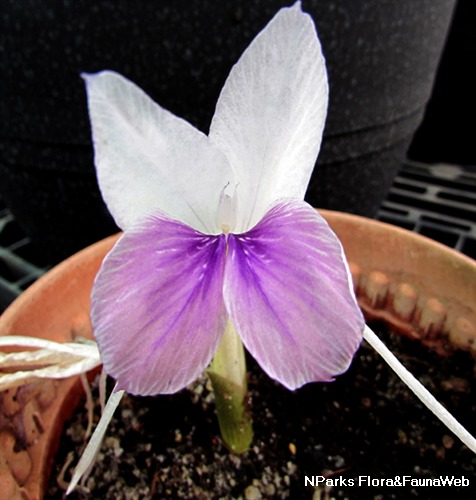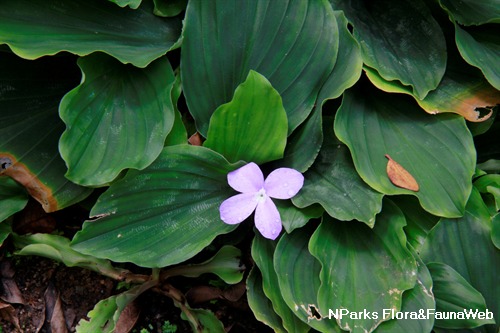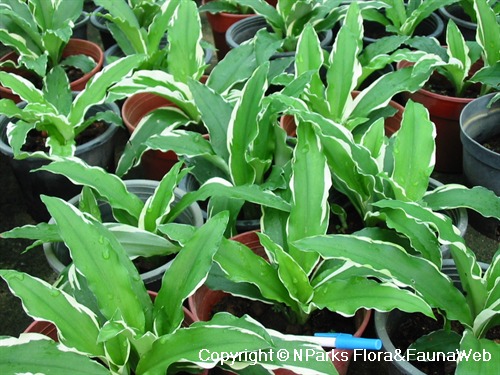
Back
Kaempferia rotunda L.
| Family Name: | Zingiberaceae |
| Synonyms: | Kaempferia bhucampac, Kaempferia longa, Kaempferia versicolor |
| Common Name: | Bhui-champha, Resurrection Lily, Blackhorm, 海南三七 |
Name
Classifications and Characteristics
| Plant Division | Angiosperms (Flowering Seed Plants) (Monocotyledon) |
|---|---|
| Plant Growth Form | Herbaceous Plant |
| Lifespan (in Singapore) | Perennial |
| Mode of Nutrition | Autotrophic |
Biogeography
| Native Distribution | Southern China, India, Sri Lanka, Myanmar, Thailand, Vietnam, Malaysia, Indonesia |
|---|---|
| Native Habitat | Terrestrial (Monsoon Forest, Grassland / Savannah/ Scrubland) |
| Preferred Climate Zone | Tropical, Sub-Tropical / Monsoonal |
| Local Conservation Status | Non-native |
Description and Ethnobotany
| Growth Form | Perennial herb. |
|---|---|
| Roots | Small, tuber-like roots form off the underground stem, known as a rhizome. |
| Foliage | The erect leaves are broad-lanceolate, measuring around 17-27 cm long. The upper side of the leaf is light-green, and dark-green along the mid-rib. The under side of the leaf is purplish. |
| Stems | This plant does not have a true stem aboveground. The underground stem, known as a rhizome, produces leaves with long stalks and also the flowering stem. |
| Flowers | Its flower arises from the underground rhizome, white with two purple lower lobes. The flowering stem is produced when the plant is leafless. |
| Ethnobotanical Uses | Food (Herb or Spice): The rhizome and young leaves are used as a spice to add flavour to food. However, care must be taken to avoid consuming excessive amounts of rhizome juice which can cause vomiting and salivation. Medicinal: The rhizome juice is used to treat throat problems, but the juice can cause vomiting and much salivation. Always consult your doctor before trying to use a plant medicinally. In India, the rhizome is dried, crushed into a powder and applied as a poultice to patients with mumps. The rhizome poultice is thought to promote the formation of pus. A study by Mohanty et al. (2008) showed that the rhizome has strong antioxidant activity which can neutralize the disease-inducing effects of harmful free radicals. |
Landscaping Features
| Desirable Plant Features | Ornamental Flowers, Ornamental Foliage |
|---|---|
| Landscape Uses | Container Planting |
Fauna, Pollination and Dispersal
| Pollination Method(s) | Biotic (Fauna) |
|---|
Plant Care and Propagation
| Light Preference | Semi-Shade |
|---|---|
| Water Preference | Moderate Water |
| Rootzone Tolerance | Well-Drained Soils, Fertile Loamy Soils |
| Propagation Method | Seed, Storage Organ |
Foliar
| Foliage Retention | Drought / Semi-Deciduous |
|---|---|
| Mature Foliage Colour(s) | Green, Green - Light Green |
| Mature Foliage Texture(s) | Thin |
Floral (Angiosperm)
| Flower Colour(s) | Purple, White |
|---|
Image Repository
Others
| Master ID | 30041 |
|---|---|
| Species ID | 4350 |
| Flora Disclaimer | The information in this website has been compiled from reliable sources, such as reference works on medicinal plants. It is not a substitute for medical advice or treatment and NParks does not purport to provide any medical advice. Readers should always consult his/her physician before using or consuming a plant for medicinal purposes. |


.jpg)


